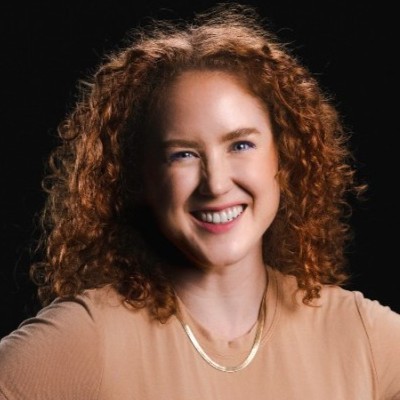Katie Hunter, Creative for Social Media at Northwestern Medicine, came to the organization a year and a half ago and was originally part of their inaugural video team. At that time, Northwestern Medicine was in the process of building out its marketing department on the creative side — which included creating a video team that could support in-house video content. Soon they realized they needed someone on the creative side dedicated exclusively to social media.
About a year into her work at Northwestern Medicine, Katie transitioned into her role as dedicated creative team member on the social media team.
“When I came to the social media team, they had done a great job of developing these robust channel strategies for Instagram, Facebook, and Twitter,” she said. “Then, once I joined, we started looking at types of creative content that would support each of these channel strategies and audiences.”
She said her primary goal for their content was around the idea of “pitch, play, and plunge.”
According to Katie, this idea came from a Facebook content strategy they discussed in one of their workshops.
“With any given story, I’m looking for the ‘pitch’ version of this that gives you everything in a couple of seconds,” said Katie. “Then, what’s the ‘play’ version that our audience can interact with? Finally, what’s the ‘plunge,’ longer form content that can give them a deep dive into the story? I’m looking at how we can get the most mileage out of any individual story.”
One of the earliest big changes she brought was the idea of audio agnostic video.
That means videos that can be played with the sound on or off. Katie found that a lot of users, especially in a mobile context, are watching videos with the sound off. But their video content wasn’t necessarily optimized for that.
“I wanted to bring the idea of audio agnostic content and now we’ve done a pretty good job of starting to make sure that any of our videos or any of our content in general, whether it’s an Instagram Story or a video posted on Facebook, are totally comprehensible and engaging even if you don’t have any sound involved,” said Katie.
Her other big addition was focusing on more programmatic content.
“My goal ultimately with our creative content is that when you go to our Facebook channel, it’s a similar experience to a standard cable channel,” she said. “So you know exactly what type of content you’re going to expect from our channels.”
To that end, she said there’s always a focus on continuous improvement and making the shows that are working better and canceling what’s not working.
One of the first series they put together as part of their new content push was “Better Lifestyles.”
“Our social audience knows that Northwestern Medicine is their premier destination during the medical crisis,” said Katie. “But we wanted to figure out how to keep Northwestern Medicine front of mind for patients even when they’re not actively seeking medical attention.”
According to Katie, Better Lifestyles was the idea to create content that would support a healthy lifestyle from an expert and clinically-driven perspective, while staying true to who they are as a brand on the leading edge of medicine.
The two pilot programs they launched after coming up with that strategic approach were a recipe tutorial series called “Better Bites” and Instagram AMAs.
The Better Bites videos were were short, audio-agnostic videos demonstrating how to cook different meals from Northwestern Medicine’s unique health perspective.
“Anybody can make a recipe tutorial video, so we wanted to find the NM way of doing it,” said Katie. “We are uniquely qualified to give people recipes that are for specific specialty diets that are for specific medical conditions and that are designed to support that healthy lifestyle through our unique expertise. They also have to look pretty and be super watchable and snackable.”
According to Katie, these recipe tutorials are more likely to drive clicks to the website, and many of the referrals that come from these food style videos are often first-time customers.

For the “Ask Me Anything” videos, Katie said the driving idea was around giving viewers access to their doctors in a way that feels personal.
“It feels one-to-one because of the way that the AMA is structured,” she said. “We don’t do them in this highly produced way that some of our other videos are — they are generally filmed on a phone or iPad.”
Because of that, she said the experience of watching an AMA on an Instagram Story is similar to the experience of watching a friend’s Instagram Stories.
“It makes these doctors seem much more relatable and accessible,” said Katie. “These were also a good substitute for our Facebook Lives, which were much longer and required a lot more team bandwidth.”
She also said the great thing about AMAs on Instagram — especially for a hospital — is that the person asking the questions is not made public unless the account chooses otherwise.
“We can have viewers send in questions and then when we answer those questions, we don’t have to tie them back to that specific user account,” said Katie. “A user that might be shy about asking a question in the comments on a Facebook Live because they don’t necessarily want to publicly ask that question.”
Through these tests, they found the metrics from their Instagram Stories have a much higher completion rate — at about 85%.
“It’s clear that our Instagram audience sticks around for more content,” said Katie. “And because the Instagram Story video segments are only about 15 seconds, it encouraged us to get these doctors to speak in sound bites and find more creative ways for the doctors to answer the question.”
They often also include an interactive component to better engage with these audiences and take advantage of the opportunities to use a multimedia approach to answering the questions in their AMAs.
Following the success of these campaigns, Katie and her team are planning to work on building out their micro-influencer program and continue experimenting with new channels.
“We want to figure out how we can engage with our micro-influencers after their takeovers and keep them in our social family,” she said. “The social team as a whole has been really involved in that and how we take these patients’ stories and bring them to life by actually letting those patients speak to our audience directly through our Instagram channel as opposed to just doing a video about them.”
They are also looking at other channels like Spotify and TikTok and how they can approach them to create a point of view for the organization.
Throughout this transition, Katie said she’s learned a lot about the different processes for different teams at Northwestern Medicine and the importance of collaboration.
“Because social doesn’t have dedicated copywriters or graphic designers, you really have to be aware of the workload and the other asks from the organizations these teams are supporting,” she said. “We had to figure out what reasonable expectations would be and how we could make sure everything still fit into the brand and voice that we wanted.”
She also said effective brainstorming has played a key role in their success.
“So often, people are afraid to say a new or unexplored idea,” she said. “To end up with an effective strategy, you need to write down every single idea that comes out, even if it’s something that you would never do because it might lead to something else. It’s important to treat brainstorming as a safe place where people can feel free to speak their minds, because that’s the best ideas will come out of those conversations.”
Katie emphasized the importance and value of approaching social media from a creative perspective and always trying to think outside the box.
“I’m bringing a creative voice in the room is showing people it’s OK to throw something at the wall that is maybe a bit out of left field or maybe something we’ve never tried before,” said Katie. “Because that willingness to put any idea out there encourages others to be bolder and think more outside the box when it comes to the creative.”
According to Katie, instead of saying “Here’s what our competitors are doing,” it’s important to look for the most effective and unique way they can present their content, while always bringing it back to the audience.


